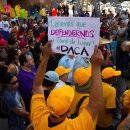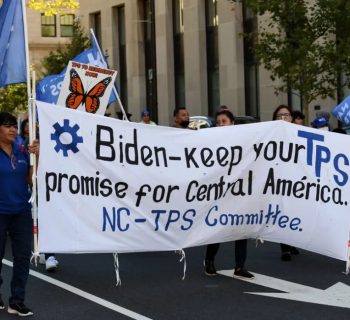|
UVALDE: FORGOTTEN HISTORY, RECOVERED
|
|
|
The following is a reprint of a letter from Camilo Perez Bustillo:
|
|
I was wondering why Uvalde rang a bell when I heard about the latest school massacre there.
Now I know why: Uvalde's Mexican community played a key role in the struggle to desegregate Texas public schools and to address the impact of that segregation through bilingual education, affirmative action, the struggle for community control of local schools, etc. One of the court-ordered remedies was the desegregation of Robb Elementary School, which was first established in 1954 as a "Mexican school".
This case, growing out of community-based activism led by Genoveva Morales, among others, led to a landmark decision (Morales v. Shannon) by the 5th Circuit Court of Appeals in 1975, reversing the lower court's refusal to find discriminatory intent. The Uvalde school district continued under court-ordered supervision until 2008.
MALDEF continued monitoring implementation of court-ordered remedies there most recently as of 2014.
Uvalde is about 40 miles from Crystal City (known in the Chicano movement simply as Cristal), which was the home base of La Raza Unida Party (LRUP), led by José Angel Gutiérrez, among others, which won citywide elections there in 1970.
There's a photo centrally positioned on the LRUP 50th anniversary website that features a party meetingin Uvalde in 1978.
Also featured there is a photo of a Raza Unida spokesperson named Irma Mireles, who may conceivably be related to Eva Mireles, the teacher who died trying to protect the children in her classroom (see her heart-rending Uvalde school district webpage, still up.
Will any national or local media pick up on this crucial thread of this story, anywhere??
|
|
|
Column by Gustavo Arellano | Los Angeles Times | MAY 25, 2022 | Photo by Wally Skalij
|
|
When I heard that a gunman had killed multiple schoolchildren in a predominantly Latino town in Texas, I immediately thought: white supremacist.
How could I not?
Just this month, a white man allegedly murdered 10 Black people in Buffalo, N.Y., while railing against Latino “replacers” in an online manifesto.
In 2019, another white man radicalized by neo-Nazi literature drove hundreds of miles to a Walmart in El Paso with the explicit mission to kill Latinos, prosecutors say. Twenty-three people died in that massacre, and multiple essays and columns tied the tragedy not just to our current era of racism and violence but to the Lone Star State’s long, shameful history of lynching Latinos.
We live in an America where millions view us as the enemy simply for being Latinos. So I girded myself to deal with yet another murderous cretin purposefully inflicting chaos on my community.
When I found out that the person who killed 19 fourth-graders and two teachers in Uvalde, Texas, on Tuesday was named Salvador Rolando Ramos, my stomach... READ MORE |
|
|
By Teresa Puente | CALÓ NEWS | MAY 31, 2022 | Photo by CALO News Wire
|
|
Beto O’Rourke is right.
“You are doing nothing,” O’Rourke told Texas Gov. Greg Abbot and other Republican politicians after the mass shooting that killed 19 children and two teachers in Uvalde, Texas. “You are offering up nothing. You said this was not predictable. This was totally predictable when you choose not to do anything.”
Many of us also feel this same indignation. Compounding this anger and pain is to see the faces of the children, mere second, third and fourth graders. A collage of their young faces has gone viral on social media.
This is the second worst school shooting in U.S. history and it is hitting the Latino community very hard. Most of the victims were Latino as are more than 80% of the residents in Uvalde, Texas. The shooter, Salvador Ramos, killed by police, also is Latino.
Ethnicity and immigration status have nothing to do with this tragedy. It is disturbing to see reports that Texas law enforcement ignored Spanish-language media. It’s the duty of law enforcement to keep the public informed, especially in a border state like Texas.
This is about guns. The community and the nation are once again devastated to see so many young children senselessly killed.
We are not powerless. This was not an act of God or something we have no control over. The nation doesn’t need thoughts and prayers. Good guys with guns can’t prevent a mass shooting as evidenced by the delayed police response in Uvalde. There is a Justice Department investigation underway.
We need more gun control. Pro-gun, Texas lawmakers are... READ MORE |
|
|
Story and photo from EFE Agency | MAY 27, 2022 | Translation from Google
|
|
Los Angeles, May 27 (EFE).- The Court of Appeals for the Fifth Circuit of the United States will hear on July 6 the arguments in a Texas lawsuit that keeps the approval of new applications from the Deferred Action for Childhood Arrivals (DACA) program paralyzed.
The hearing will respond to the appeal made by the government of President Joe Biden to the ruling of a federal court that considered immigration benefit illegal, which offers work permits and protection against deportation to people who arrived in the country irregularly as children.
On July 16, 2021, Federal Judge Andrew Hanen sided with a group of Texas-led Republican states that called for an end to the program, considering that the government of now former President Barack Obama (2009-2017) violated the procedural law by establishing the program.
As part of his decision, Hanen ordered the Government to stop approving new applications, although he did allow the renewal of existing amparos, considering DACA to be illegal because the Obama Administration exceeded its authority when it created the program in 2012... READ MORE
|
|
|
Report by Boundless | MAY 24, 2022 | Photo by AP
|
|
As the Deferred Action for Childhood Arrivals (DACA) program enters its tenth year, a Boundless report analyzes public data to get a picture of who DACA recipients are, as well as the challenges and opportunities they face.
Since its inception in June 2012, the Deferred Action for Childhood Arrivals (DACA) program has provided temporary relief from deportation as well as work authorization to undocumented young people across the United States.
As of December 2021, the end of the first quarter of the 2022 fiscal year, and the most recent quarter for which USCIS has released data, there were approximately 611,470 DACA recipients. Of these over 600,000 people, more than half are female, and two-thirds are between the ages of 20 and 30 years old.
Using data from the 2021 National DACA Study, Boundless found that about a third are currently in school, with the majority pursuing a bachelor’s degree and some an associate’s or master’s degree. Almost 70% had, or were on track to obtaining, a bachelor’s degree or higher at the time of the survey.
Almost 80% of DACA recipients also reported being employed after their DACA application and attendant work authorization was approved, compared to less than half that number prior to approval. Receiving a grant of DACA also doubled recipients’ average income, from about $11/hour before DACA to nearly $23/hour after, which brought the average annual income for a DACA household on par with the median... READ MORE |
|
|
By Rafael Bernal | The Hill | MAY 27, 2022 | Photo from Getty Images
|
|
Around 100,000 undocumented immigrants will graduate high school in 2022 without a shot at work permits, the first time in a decade that a majority of so-called Dreamers will not be eligible.
Most undocumented 2022 graduates have not been in the country long enough to be covered by Deferred Action for Childhood Arrivals (DACA), the Obama-era policy that was the focus of attacks and litigation during the Trump administration. Immigrants covered by DACA are known as Dreamers.
DACA was put in place as a temporary stopgap in 2012, giving the right to work and study, and deferral from potential deportation, to undocumented immigrants who arrived in the country as minors before 2007.
According to a new report by FWD.us, a tech industry-linked immigration advocacy group, U.S. high schools this spring will grant diplomas to 100,000 young undocumented immigrants... READ MORE |
|
|
By Margaret D. Stock | Washington Post | MAY 25, 2022 | Photo by AP
|
|
Today’s U.S. military is facing a personnel deficit that is affecting our nation’s readiness and threatening our national security. But if our leaders are willing to act, there’s an obvious solution to this problem: immigrants.
Last year, the military failed to meet its recruiting goals, even though at least one branch, the Army, was offering a record $50,000 signing bonus to anyone willing to commit to a tour of six years. Part of the problem is that, like other employers, the armed services are competing for candidates in the midst of a labor shortage. They also, however, face a fundamental demographic challenge: The total U.S. population is growing at its slowest rate in history.
On top of that, there’s the quality-candidate issue. Increasingly, Americans who do apply are rejected. According to the Centers for Disease Control and Prevention, even if they wanted to join, 71 percent of young people cannot meet military requirements. One in four is overweight. Others either fail to meet the education requirements necessary to serve in a high-tech 21st-century military or have mental health challenges or a drug abuse or criminal record.
But a key reason the military can’t meet its recruiting goals is our nation’s problem with immigration... READ MORE |
|
|
Opinion by the Seattle Times Editorial Board | MAY 25, 2022 | Art image by Paul Tong
|
|
The never-ending stream of divisive rhetoric around immigration and the southern border has long hindered comprehensive reform, as both Democrats and Republicans have made political hay out of a broken system.
The latest flashpoint is the end of Title 42, a Trump-era border-control measure that upended the legal rights of asylum-seekers under the guise of protecting public health during the pandemic. The matter is currently tied up in the courts but some U.S. senators seek to extend the order until 2025.
That would be unconscionable as well as counterproductive.
Instead of swiftly deporting migrants and interfering with the legal processmeant to protect those fleeing persecution, Congress should focus on solutions that not only tackle the factors that draw people to cross the border illegally but also acknowledge and address the labor needs of the United States.
One of those common-sense options is the Farm Workforce Modernization Act. It is the kind of clear-eyed, practical legislation that deserves attention.
Proposed by U.S. Reps. Dan Newhouse, R-Wash., and Zoe Lofgren, D-Calif., the legislation passed the House in 2021 with bipartisan support but has so far stalled in the Senate.
The act would give some immigrant workers without legal permission to be in the U.S. a path to legal status and streamline the visa-application process to make it easier for foreign workers to come here legally. It would also require employers to verify a worker’s identity and employment authorization.
Immigrants make up more than 70% of U.S. farmworkers.
“Most farmers would agree that the No. 1 issue they face is the lack of labor. Crops don’t harvest themselves,” Newhouse, the state’s former agriculture director, said in a news release. “This legislation would secure a legal, and reliable, workforce for all of agriculture.”
Along with the impact on farm work and the nation’s food supply, labor shortages are a contributing factor to widespread inflation, according to the U.S. Chamber of Commerce, which has called for an increase in legal immigration to help solve the problem.
Over the last nine months, the number of unfilled nonfarm jobs has consistently surpassed 10 million. Data for March shows there are more than 11 million unfilled positions in the U.S. labor market... READ MORE |
|
|
Study by FWD.us | MAY 25, 2022
|
|
Under current rules and court action, DACA is unavailable to most undocumented high school graduates. Absent Congress’ passing immigration reform for Dreamers, most undocumented graduates cannot legally enter the workforce, even if the DACA policy were open for new applicants. Without more states passing tuition equity legislation, many undocumented graduates also cannot access affordable higher education.
FWD.us estimates that some 100,000 undocumented young people will graduate from high school this spring.1Part of the larger 2.8 million-strong Dreamer population, these undocumented students came to the U.S. as children, and have spent most of their lives in this country.2 With more than 600,000 K-12 undocumented students enrolled in U.S. schools, hundreds of thousands of future high school graduates will continue to face limited options for their futures without immigration relief. In fact, FWD.us estimates that at least 100,000 undocumented students will graduate from U.S. high schools each year for at least the next three years.
As undocumented high school seniors across the country prepare to receive their diplomas, most will encounter greater challenges than previous classes of undocumented graduates. Deferred Action for Childhood Arrivals (DACA), a DHS policy offering work authorization and deportation protections for undocumented individuals who entered the U.S. as children, has been life-changing for hundreds of thousands of Dreamers since its inception in 2012. And, as it has been for so many other undocumented high school graduates in recent years, such a policy holds transformative potential for future high school graduates. But now, only a quarter of this year’s undocumented high school graduates would be eligible for immigration relief through DACA... READ MORE
|
|
|
By Jesus Garcia | La Opinion | JUNE 1, 2022
|
|
Women are the main recipients of remittances in Mexico, although men are keyly represented when receiving dollars from immigrants living in the United States, according to a recent analysis by the Center for Latin American Monetary Studies.
Almost 12 million Mexicans receive money from their relatives living in the United States and highlights that a high percentage of households have women as heads of household.
"When considering only households receiving remittances, it turned out that in 37.4% of them the head of household was a woman and such a percentage varied from 33.4% in the West and Bajío region to 43.3% in the South and East Center," says an analysis by the Center for Latin American Monetary Studies (CEMLA) and the Latin American and Caribbean Remittance Forum.
The data were obtained from the National Financial Inclusion Survey (ENIF) 2021, carried out by the Mexican National Banking and Securities Commission (CNBV) and the National Institute of Statistics and Geography (INEGI).
It is indicated that 11.1 million adults were recipients of remittances, of which 4.6 million were men and 6.5 million were women.
There are 4.9 million households that receive funds from immigrants in the United States, and 1.8 million women are the recipients, considered "head of household."
The region with the highest number of recipient households was the West and Bajío with 1,604 million and highlights that Mexico City has the fewest households with 112,065... READ MORE LEER MAS EN ESPANOL
|
|
|
By Molly Hennessy-Fiske | Los Angeles Times | MAY 19, 2022 | Photo by Justin Hamel
|
|
DALLAS — The U.S. Senate unanimously passed legislation co-sponsored by Sen. Alex Padilla (D-Calif.) to turn a formerly segregated, “Mexican” school in west Texas into a historic site, the first of its kind.
“We’ve taken an important step in telling a more inclusive story of the rich, yet often painful, story of our nation,” Padilla said after the vote Thursday. “Latino history is American history. Understanding our nation’s history of segregation and discrimination in places like the Blackwell School, which serves as an important touchstone of Mexican heritage in Marfa, is integral to building a more inclusive and just future for our country.”
Segregated schools once educated Mexican Americans across the Southwest, but theyhave since been abandoned or converted into offices and community centers. The Blackwell School in Marfa — about 180 miles southeast of El Paso — is one of the few still standing. Opened in 1909 as a three-room “Mexican school,” Blackwell expanded to half a dozen buildings, educating more than 4,000 children before it closed... READ MORE |
|
|
By Graciela Mochkofsky | The New Yorker | MAY 18, 2022 | Photo from Alcaraz's Instagram
|
|
Does winning a prestigious award mean that Alcaraz is now accepted by the mainstream?
Like many prestigious awards that recognize great accomplishment in this country, the Herblock Prize for editorial cartooning, created in 2004 to commemorate the legacy of the late Washington Post cartoonist Herb Block, had never been offered to a nonwhite person—until this year. While accepting the prize at the Library of Congress on the evening of April 27th, Lalo Alcaraz, a Chicano from San Diego, California, said what many of his friends and followers were posting on social media: “It’s about time.”
For the past thirty years, Alcaraz, who is also the first Latino political cartoonist to author a nationally syndicated comic strip, has used a caustic, take-no-prisoners humor against anti-immigrant and racist public figures. “No other political cartoonist working in the U.S. brings as much passion, dedication and brilliance to the fight for fair immigration at the border and justice for the Latino community,” the Herblock judges stated.
In 2020 and 2021, Alcaraz had been a Pulitzer Prize finalist in the editorial-cartooning category, but, last year, in a decision that angered many cartoonists, the board chose not to declare a winner and has since eliminated that particular category. The Herblock Prize, then, signalled a triumph for an artist beloved in the Latinx community but who, like the community itself, has long felt a lack of recognition from mainstream America. Now he has finally been accepted. Or has he?
“I get a lot of hate mail,” Alcaraz said in his acceptance speech. A few days later, during a Zoom call from Los Angeles, he told me, “There is still this American societal attitude that we are foreign.”
He is not, in fact, foreign. The child of immigrants who moved to this country from the Mexican states of Sinaloa and Zacatecas, Alcaraz was born in 1964 in San Diego, a city, he told me, that was “in denial that it was on the U.S.-Mexico border.” He grew up witnessing and experiencing discrimination and racism—from cops pulling him over for no reason, when he rode his bike as a kid, to “shoplifting police,” following him and his mother in stores, to a large outdoor swap meet that ended with Border Patrol cars and helicopters chasing a group of undocumented immigrants as a crowd of horrified Mexican Americans watched. These experiences, he said, put “the politics of the border in front of my eyes... READ MORE
|
|
|
A POEM FOR UVALDE: "The Good Old Boys"
|
|
|
|
Los buenos viejos muchachos
se reunieron para en público decir sus vacías,
pietistas condolencias y oraciones
por los niñ@s y maestras asesinad@s
con el rifle que les pusieron, como la gallina
prometida en cada olla, en las manos
de cualquiera que quisiera uno: mocosos,
los locos, los llenos de odio. Y cuando uno
de conciencia los denunciaron, gritaron:
“Estás fuera de lugar, estás fuera de lugar;
estás haciendo de esto cosa política.”
Como si no lo fuera hasta sus mismas raíces —
las armas, la locura, la codicia, la crueldad
todo legislado o ignorado. Si esto
no llama a la revolución ¿qué lo hará?
Si el amor y la justicia violados callan,
amordazados y ojos vendados
¿qué de la esperanza?
Ha llegado el momento (como siempre ha sido)
para hacer nuestra revolución.
|
|
|
The good old boys
gathered to publicly say their empty
pietistic condolences & prayers
for the children & teachers murdered
with the gun they put, like the promised
chicken in every pot, into the hands
of anyone who wanted one: kids,
the insane, the hate-filled. And when one
of conscience called them out, they yelled:
“You’re out of line, you’re out of line;
you're making a political issue of this.”
As if it were not to its very roots —
the guns, the insanity, the greed, the cruelty
all legislated or ignored. If this does
not call for revolution, what will?
If love & justice outraged remain silent,
gagged & blindfolded, what of hope?
The time is come (as it always has)
to make our revolution.
© Rafael Jesús González 2022
|
|
|
Latino Theater Company Presents the return to the LATC OF
ANDRE & DORINE
by Kulunka Teatro
Directed by Iñaki Rikarte
This special event is on Wednesday, June 8th at 8:00 PM and is only for our most valued supporters and friends. Space is very limited. Click on the flier above for more info.
André & Dorine is a poignant depiction of the enduring love between an elderly couple as their lives are disrupted, but not overcome, by Dementia.
Performed by the Internationally-Acclaimed Kulunka Teatro (which received the Spanish equivalent of a Tony Award for Best Play in 2018), this non-verbal theatre piece uses movement, puppetry, and mask to celebrate the shared lives of a pair of artists - André with his typewriter, Dorine with her Cello - and how they relive and reinvent their love together as Alzheimer’s becomes a permanent part of their relationship.
|
|
|
Centro CHA Community Update
|
|
|
Enrollment Event For CalFresh
Centro CHA will be hosting an enrollment event for CalFresh.
We invite you to join our event on Thursday, June 9 & the 23, from 2:30 to 5:00 PM.
Please call (562) 612-4180 to RSVP and/or learn more about our event!

|
Evento De Inscripcion Para CalFresh
Centro CHA tendrá un evento de inscripción para CalFresh.
Los invitamos a participar en nuestro evento el
Jueves 9 de Junio y el 23, de 2:30 a 5:00 PM.
Por favor llame al (562) 612-4180 para confirmar su asistencia y/o
aprender más sobre nuestro evento!
|

|
|
Please consider sponsoring our program today!!!
To be a sponsor contact Professor Armando Vazquez-Ramos at: armando@calmexcenter.org or 562-972-0986
|
|
|
|
|


























